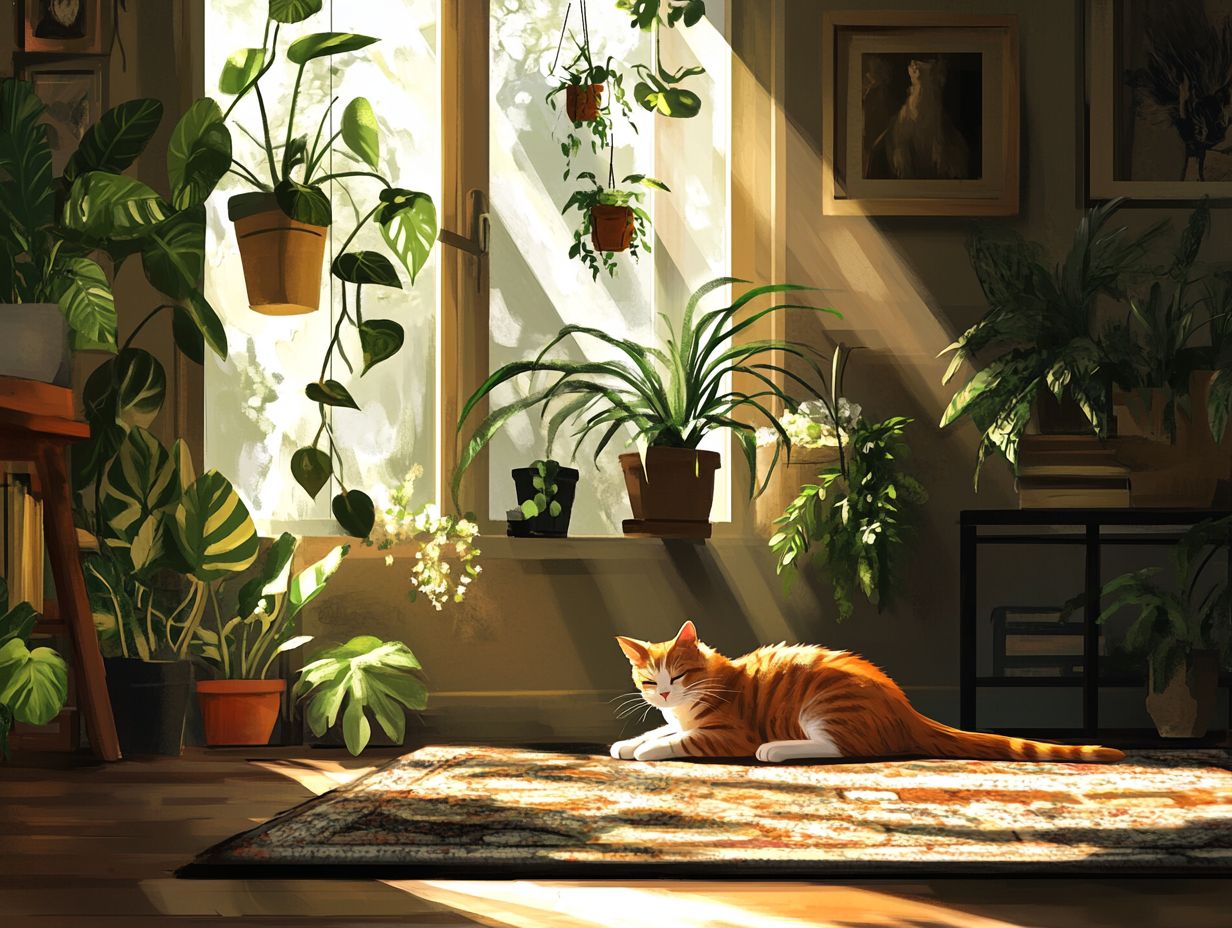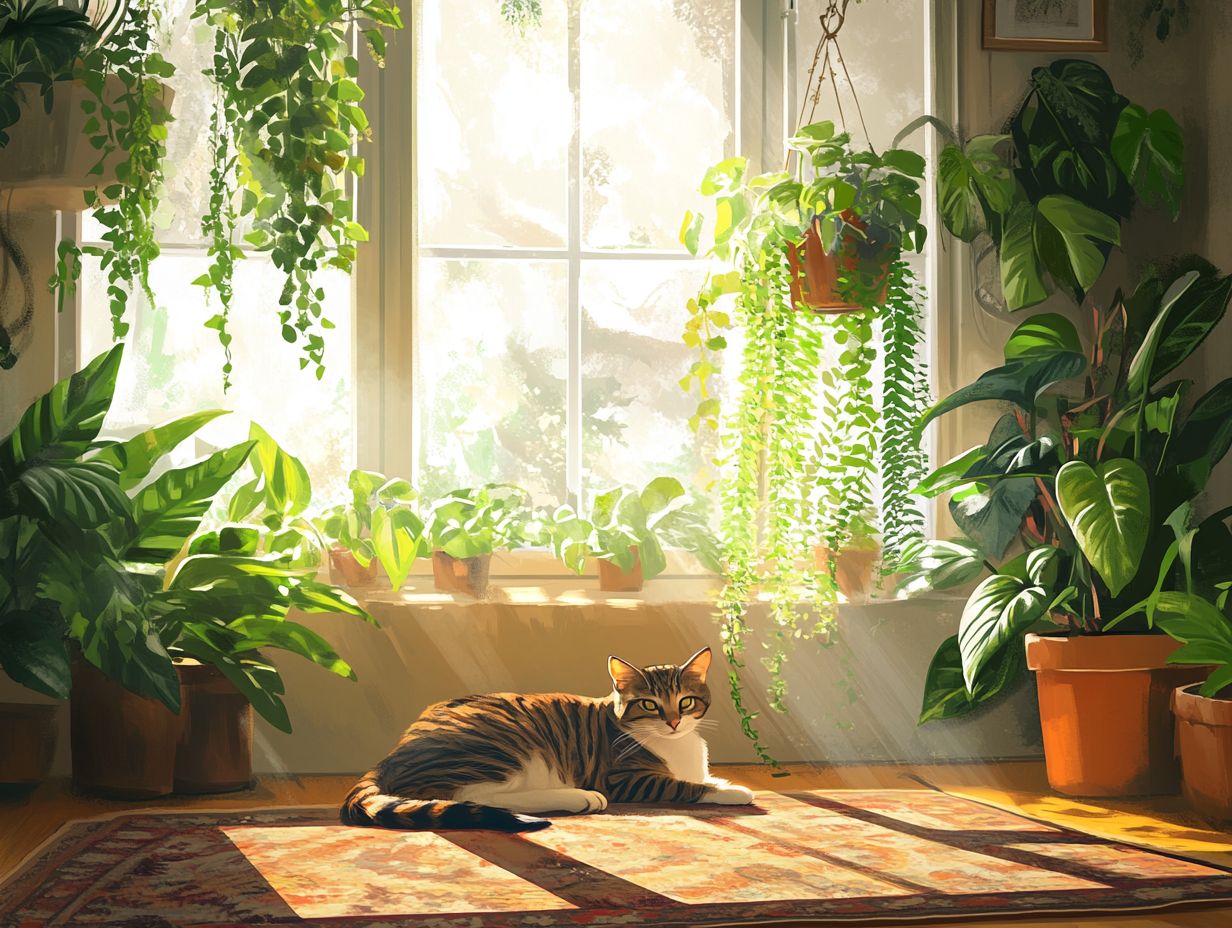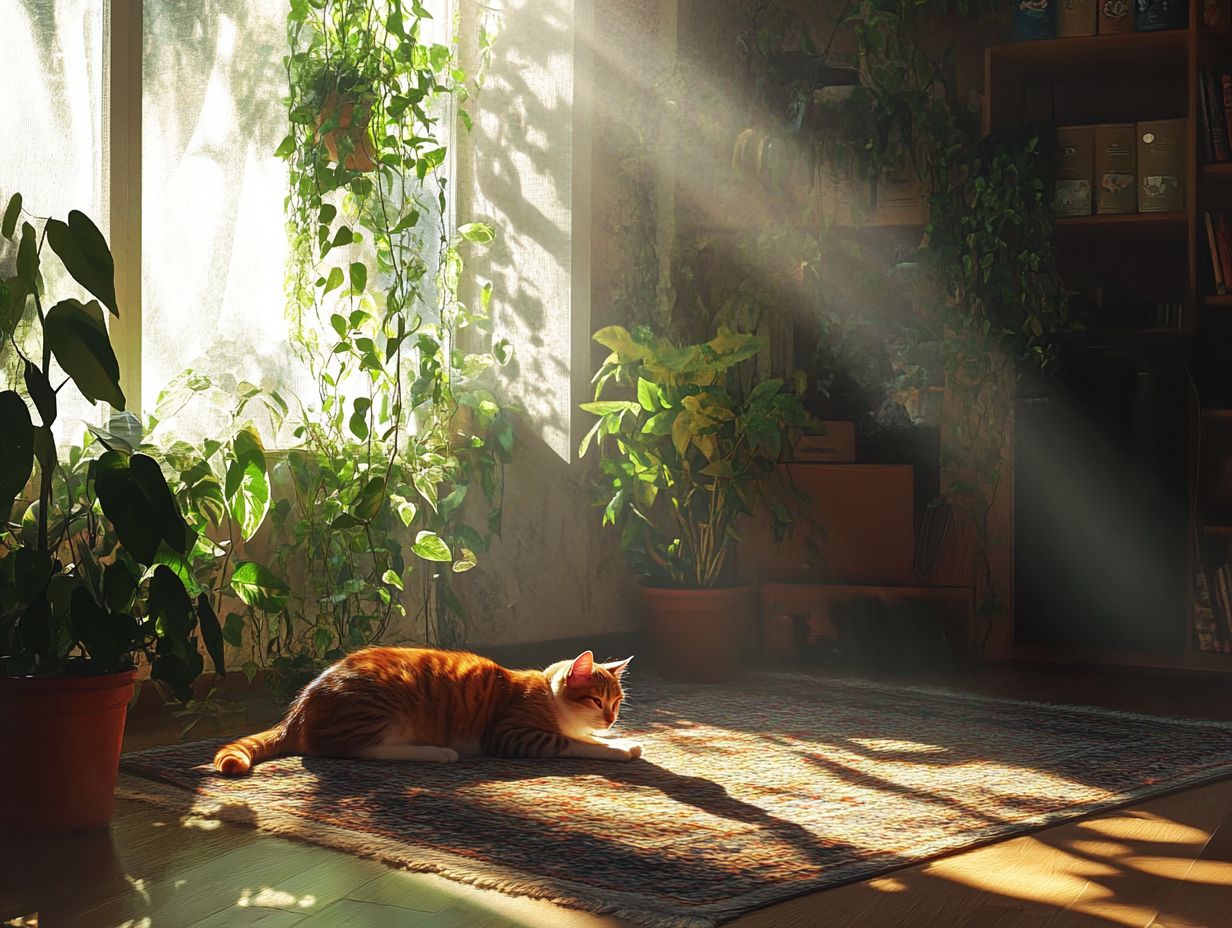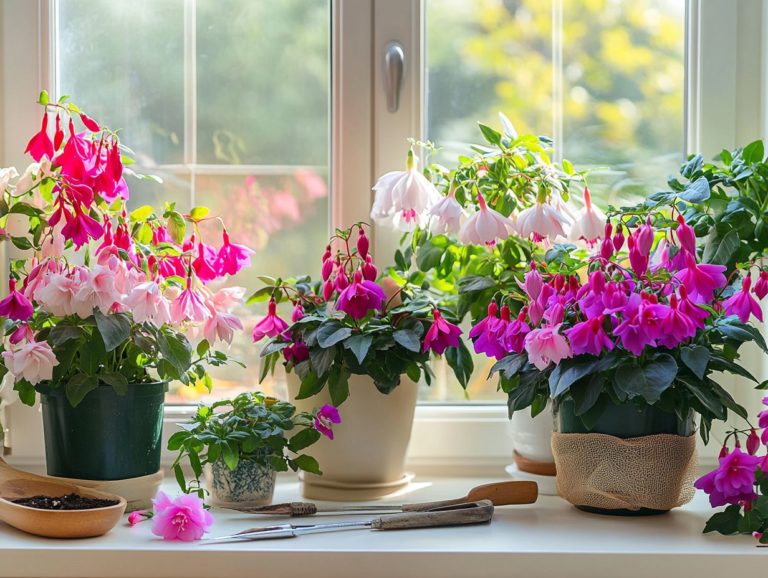Best Indoor Plants for Pet Owners
Creating a vibrant indoor space can be quite the endeavor for pet owners, particularly when selecting plants that are safe for your furry companions and visually appealing. This guide delves into a range of indoor plants that tick all the boxes from pet-friendly options to low-maintenance varieties, air-purifying plants, and those that elevate your home s aesthetics. You will also find best practices to foster a harmonious environment for both your pets and your plants. Let’s explore exciting options together to discover the finest indoor plants that perfectly suit your unique lifestyle!
Contents
- Key Takeaways:
- 1. Pet-Friendly Indoor Plants
- 2. Low-Maintenance Indoor Plants
- What Are Some Easy-to-Care-For Indoor Plants?
- How Can Pet Owners Choose Low-Maintenance Plants for Their Homes?
- What Are Some Tips for Keeping Indoor Plants Healthy and Thriving?
- Air-Purifying Indoor Plants
- What Are the Benefits of Having Air-Purifying Plants in the Home?
- What Are Some Recommended Air-Purifying Plants for Pet Owners?
- How Can Pet Owners Ensure Their Indoor Plants Are Effectively Purifying the Air?
- 4. Aesthetically Pleasing Indoor Plants
- 5. Best Practices for Pet Owners with Indoor Plants
- Frequently Asked Questions
- What are the best indoor plants for pet owners?
- Are there any indoor plants that are toxic to pets?
- Can indoor plants improve air quality for pets?
- How can I keep my pets from damaging my indoor plants?
- Which indoor plants are easy to care for as a pet owner?
- What should I do if my pet accidentally eats a toxic indoor plant?
Key Takeaways:

- Pet owners should prioritize safety and choose non-toxic indoor plants for their homes to avoid potential harm to their furry friends.
- Low-maintenance indoor plants, such as succulents or spider plants, are ideal for pet owners who may not have a green thumb.
- Indoor plants not only purify the air but also add beauty to a home. Pet owners can incorporate them into their decor and arrange them strategically for maximum aesthetic appeal.
1. Pet-Friendly Indoor Plants
For pet owners, choosing indoor plants isn t just about creating a beautiful space; it s also about ensuring the safety of their furry friends. You need to select pet-friendly plants that won’t pose any risks to your beloved companions. This thoughtful approach opens up a world of options, such as the Spider Plant. It thrives in bright, indirect light and doubles as an air purifier, making it an excellent addition to your shared environment.
Then there’s the Baby Rubber Plant, boasting glossy leaves that bring a vibrant touch without the worry of toxicity perfect for those who prefer low-maintenance greenery. Similarly, the Rattlesnake Plant, with its eye-catching patterns, loves humidity and indirect sunlight, adding a unique flair to your indoor garden.
To keep these plants thriving, establish a watering schedule that prevents waterlogging while maintaining humidity levels between 40-60%. It’s crucial to be aware of toxic plants like Lilies and Philodendrons. By understanding these risks and nurturing pet-safe plants, you can grow a flourishing indoor garden that ensures your cherished companions remain safe and sound.
What Are Some Safe Indoor Plants for Pets?
Safe indoor plants for pets are a must for any responsible pet owner who wants to introduce a touch of greenery to their home while ensuring a safe haven for their furry companions. Consider options like the Spider Plant and Baby Rubber Plant; both are visually stunning and completely non-toxic to cats and dogs, making them perfect additions to your pet-friendly environment.
The Boston Fern is another great choice, thriving in humid conditions and needing just indirect sunlight. Its lush, feathery foliage adds an inviting texture to any room. Then there’s the Parlor Palm, which requires minimal care and low light, all while exuding a delightful tropical vibe.
If you re after a splash of color, the Calathea, with its striking patterned leaves and contrasting shades, will bring an artistic flair to your interiors. These plants not only enhance your living space but also improve air quality, playing a vital role in creating a healthier indoor atmosphere for both you and your beloved pets.
How Can Pet Owners Ensure Their Indoor Plants Are Safe for Their Pets?
To ensure your indoor plants are safe for your pets, it s essential to educate yourself about various plant species and consult reputable resources like the ASPCA, Architectural Digest, or your veterinarian for expert advice on toxic houseplants. Understanding which plants are toxic and taking proactive measures to monitor your pet’s behavior around them can significantly reduce potential risks.
Once you’ve identified any questionable species, it s a smart move to create physical barriers think shelves or plant hangers that keep them out of reach of curious paws. Regularly observing how your pets interact with your greenery can offer valuable insights into any behavioral changes or newfound interests.
Keeping a log of which plants capture your pet’s attention will help you make informed decisions for future plant purchases, ensuring a harmonious home for both your flora and furry friends.
Explore more about pet-friendly plants or share your experiences with indoor gardening!
What Are Some Common Toxic Plants to Avoid?
Identifying common toxic plants is essential for you as a pet owner. Many popular houseplants can pose serious health risks to your furry friends. Plants like the Venus Flytrap and certain varieties of Bromeliads are known to be toxic houseplants. Their presence in your home could lead to unfortunate accidents if ingested by your curious pets, so always research toxic plants.
Other hazardous plants frequently found in households include the Philodendron and Pothos. These can cause stomach problems, including vomiting and diarrhea. This can be particularly concerning if your pet consumes a significant amount, potentially leading to more serious complications.
It’s vital for you to thoroughly research any plants you’re considering bringing into your home. Even non-flowering varieties can be harmful. For those looking for suitable options, exploring the top 10 indoor plants for artificial light can be helpful. Being vigilant in your plant selection not only safeguards your pets from immediate dangers but also cultivates a serene living space where both pets and plants can thrive in harmony.
2. Low-Maintenance Indoor Plants
Low-maintenance indoor plants are your best bet if you’re a busy pet owner looking to elevate your living space without pouring hours into plant care. Varieties like the Ponytail Palm and Boston Fern thrive with minimal attention and can adapt to various conditions. They make perfect companions while you juggle pet care and houseplant responsibilities.
Getting to know each plant’s unique traits is crucial and can be fun! Some flourish in bright, indirect light, while others are more than happy in lower light settings. This understanding enables you to choose the plants that best fit your home.
Look for resilient options like the Snake Plant or ZZ Plant, which typically require only occasional watering. As a pet owner, you’ll want to keep an eye on factors like humidity levels and the natural light in your space to ensure optimal growth.
A handy rule of thumb for watering is to let the top inch of soil dry out before giving your plant a drink. This simple tip can help you avoid the all-too-common pitfall of overwatering.
By selecting indoor plants that thrive in low light and following a straightforward care routine, you can bask in the beauty of greenery while also enriching your pets’ surroundings.
What Are Some Easy-to-Care-For Indoor Plants?
Easy-to-care-for indoor plants are perfect for you if you’re a pet owner looking to infuse your space with nature while avoiding the extensive upkeep that often comes with plant care. Think about the resilience of plants like the Hoya Varieties and Fishbone Cactus, which thrive with minimal attention ideal companions for your busy lifestyle.
Other excellent choices include the Snake Plant and Pothos, both renowned for their forgiving nature and adaptability to various lighting conditions. For more options, check out the top 10 best indoor plants for offices. These plants require infrequent watering, allowing you to bask in greenery without the constant worry of maintaining delicate specimens.
Such low-maintenance indoor plants not only elevate your home environment but also pose no significant risk to your pets. This makes them a thoughtful choice for those concerned about their furry friends safety. Ultimately, selecting the right plants can create a harmonious atmosphere in your dynamic household and promote a sense of calm.
How Can Pet Owners Choose Low-Maintenance Plants for Their Homes?

You can effortlessly select low-maintenance plants by evaluating your home environment. Choose varieties that fit your lifestyle while ensuring pet safety. By researching plant characteristics, such as their light and humidity needs, you ll discover suitable options that demand minimal effort and keep your pets safe.
Consider how much natural light your living spaces receive throughout the day. Some plants flourish in bright, indirect light, while others are perfectly content in low-light conditions. Humidity levels are another crucial factor; for instance, tropical plants often thrive in more humid environments, which can be a challenge in drier homes.
Above all, it’s essential to choose non-toxic plants. Curious pets may be tempted to nibble on leaves. Making safe selections is vital not only for aesthetics but also for the health of your furry companions. For those looking to enhance their home, consider the top indoor plants for varied lighting that are safe for pets.
What Are Some Tips for Keeping Indoor Plants Healthy and Thriving?
Keeping your indoor plants healthy and thriving requires a keen eye for detail and a solid grasp of basic plant care practices, especially if you re a pet owner juggling the needs of your furry companions. Choosing the right potting mix is a game changer for your plants! It promotes drainage while retaining moisture, allowing the roots to breathe adequately.
Establishing a consistent watering schedule and monitoring humidity levels are essential for ensuring that plants like the Calathea Orbifolia and Bromeliad flourish. Adopting a balanced nutrient plan during the growing season can significantly enhance your plants’ overall vigor.
Regularly observing the color of leaves and the growth of stems can give you valuable insights into whether your plants are thriving or in distress. This enables timely adjustments to their care routine. Positioning your plants away from temperature fluctuations and direct drafts is key to crafting an ideal microclimate for indoor gardening success.
Air-Purifying Indoor Plants
Air-purifying indoor plants do more than just enhance the beauty of your space; they boost your health! They provide significant health benefits, making them an ideal choice for you, especially if you’re a pet owner concerned about indoor air quality.
Take the Peace Lily and Spider Plant, for example. These varieties excel at removing common airborne pollutants like formaldehyde and benzene. The Peace Lily features striking white flowers that not only elevate your decor but also thrive in low light areas in your home, making it a perfect fit for various spaces.
To keep these plants thriving and enjoy the best air quality, provide adequate light, water them appropriately, and consider occasional fertilization. Don’t forget to regularly dust the leaves, as this enhances their ability to absorb toxins.
If you re a pet owner, prioritizing the health of your plants is crucial. Address any signs of stress, like yellowing leaves, to maximize the air-purifying benefits for your furry friends.
What Are the Benefits of Having Air-Purifying Plants in the Home?
Having air-purifying plants in your home offers a wealth of advantages, from enhancing air quality to reducing stress and helping you feel better for both you and your pets. By introducing varieties like the Boston Fern and Rattlesnake Plant, you can create a serene living environment that actively supports your well-being.
These plants not only elevate the aesthetic of your space but also possess the remarkable ability to filter harmful toxins, such as formaldehyde and benzene, from the air. Research conducted by NASA underscores the significant impact these green companions can have on maintaining a healthier indoor atmosphere, as they naturally absorb pollutants and release fresh oxygen.
Studies show that interacting with indoor plants can lower anxiety levels and promote mental wellness. By ensuring a mix of these resilient species, you make it easier to cultivate a green sanctuary that is both safe and beneficial for your furry friends.
What Are Some Recommended Air-Purifying Plants for Pet Owners?
For pet owners, choosing the right air-purifying plants is essential for creating a safe and healthy environment. Consider options like the Spider Plant and Baby Tears; both are non-toxic and perfect for your furry friends. These plants not only improve air quality but also thrive in typical household conditions, making them excellent additions to pet-friendly homes.
Beyond Spider Plants and Baby Tears, explore Peace Lilies and Boston Ferns. These remarkable plants are known for their impressive ability to filter harmful toxins from the air. When caring for these green companions, ensure they receive indirect sunlight and moderate watering to keep them vibrant. For more options, check out the top 5 indoor plants for bright spaces. It’s wise to place them out of reach of curious paws.
By incorporating these plants into your home, you’ll help reduce indoor pollutants and enhance overall air freshness, creating a space that is not just visually appealing but also healthier for both you and your pets. Explore the top 5 indoor plants for beginners and start caring for your plants today to enjoy a healthier home!
How Can Pet Owners Ensure Their Indoor Plants Are Effectively Purifying the Air?
To ensure your indoor plants are truly purifying the air, focus on proper care and thoughtful placement. Provide adequate light, water appropriately, and maintain suitable humidity levels.
Regularly checking each plant’s health makes a significant difference. Some varieties thrive in brightness, while others prefer shade; understanding these needs helps you maximize their effectiveness.
Adapting care routines like pruning dead leaves and repotting can prevent issues that hinder a plant’s ability to remove harmful substances. By implementing tailored practices, you enhance air quality and promote lush growth.
4. Aesthetically Pleasing Indoor Plants
Aesthetically pleasing indoor plants can transform your home into a vibrant sanctuary filled with life and color. This is especially true for pet owners who appreciate natural beauty.
Consider plants like the Spider Plant and Boston Fern; they not only elevate your space but are also safe for your furry friends. Use cascading plants on shelves or hang macram planters from the ceiling for dynamic visual interest.
Choose pots in complementary colors soft pastels for a serene vibe or bold hues for drama. Integrating greenery into functional spaces ties together different design elements.
What Are Some Indoor Plants That Can Add Beauty to a Home?

Indoor plants can transform your home with unique appearances. From the Baby Rubber Plant’s textures to the vibrant Staghorn Fern, these plants cultivate a soothing atmosphere.
Take the Peace Lily, for example. Its glossy leaves and elegant blooms not only add sophistication; they also excel at filtering indoor air pollutants.
The Snake Plant features architectural leaves that bring a modern touch. It converts carbon dioxide into oxygen at night, ensuring you enjoy a restful sleep.
By selecting such indoor plants, you enhance your home s aesthetic while nurturing a tranquil ambiance.
How Can Pet Owners Incorporate Indoor Plants into Their Home Decor?
You can blend indoor plants into your decor by selecting spots that showcase their beauty and keep your pets safe. Position plants in areas with bright, indirect light for healthy growth.
To create harmony, place taller plants, like snake plants or rubber trees, in overlooked corners. For smaller varieties, group succulents or spider plants on shelves or tables.
Integrate plants with your decor by matching their colors to cushions or artwork. Choose decorative pots that reflect your style, ensuring the greenery feels like a natural extension of your home.
What Are Some Tips for Arranging Indoor Plants for Maximum Aesthetic Appeal?
Arranging indoor plants for maximum aesthetic appeal requires a keen eye and thoughtful placement. This allows you to create a unified look throughout your space. By incorporating varying heights, colors, and textures, you can enhance your decor while ensuring a pet-friendly environment.
To achieve this optimal arrangement, consider grouping plants in clusters by height. Position taller varieties at the back and shorter ones in front to create depth. Color coordination is also essential; contrasting lush greens with vibrant blooms captivates the eye and maintains a lively atmosphere.
Using plant stands or shelves elevates your greenery and minimizes the risk of curious pets accessing delicate plants. For those looking to enhance their space, consider the best indoor plants for west-facing windows. Place these elements away from common pet pathways to preserve both the aesthetic quality of your living space and the safety of your furry friends.
5. Best Practices for Pet Owners with Indoor Plants
For pet owners, ensuring the safety of cherished companions while nurturing indoor plants requires a thoughtful approach. You should consider pet-friendly varieties like Fishbone Cactus and Baby Tears. It’s also important to avoid common pitfalls such as overwatering or selecting toxic plants that could harm your pet.
By understanding indoor plant safety and following expert advice, you can create a flourishing indoor garden that enhances your life without compromising your pets’ well-being.
Make it a habit to research houseplants regularly to stay informed about which species are non-toxic. Implementing strategies like placing plants on elevated surfaces or using hanging planters can effectively prevent curious pets from reaching them.
Creating barriers can help discourage your pets from nibbling on leaves. Using deterrents like citrus scents may also be effective.
It s crucial to observe how your pets interact with plants. Any changes in behavior may indicate potential issues. Regular consultations with veterinarians about safe gardening practices can contribute to maintaining a secure home, allowing both lush greenery and peaceful living to thrive together.
How Can Pet Owners Ensure the Safety of Their Pets Around Indoor Plants?
To ensure the safety of your pets around indoor plants, you must take proactive measures. Start by educating yourself about plant toxicity. Place plants where your pets can’t get to them. By monitoring your pet’s behavior and adjusting plant arrangements as needed, you can significantly minimize risks.
Creating physical barriers, such as using decorative plant stands or placing pots in hanging planters, prevents curious paws from reaching hazardous leaves. Offering suitable alternatives, like chew toys or cat grass, can effectively divert your pets’ attention from tempting greenery.
Regularly check on your plants’ health. This helps them thrive and lets you identify potential dangers, such as wilting or rotting leaves that might attract your pets. By taking these steps, you can cultivate a safer environment that accommodates both your beloved plants and furry companions. Additionally, consider incorporating some of the top air-purifying indoor plants to enhance your living space.
What Are Some Tips for Maintaining a Healthy Environment for Both Pets and Plants?
Maintaining a healthy environment for both your pets and plants requires careful planning and a mindful approach. This ensures that everyone in your household thrives. Select suitable indoor plants, establish proper care routines, and create spaces that promote the well-being of both your furry friends and your greenery.
Understanding how different plants can enrich your space while remaining safe for curious pets significantly enhances your home’s atmosphere. Consider incorporating famous foliage plants for indoor decor into your collection. A consistent watering schedule keeps your plants healthy and offers a bonding routine where you can observe your pets’ behaviors, fostering a deeper connection.
Choosing non-toxic plants means your pets can explore without fear of harm, encouraging a harmonious coexistence. Incorporating pet-friendly plants like spider plants or Boston ferns further elevates your environment, enhancing both air quality and the aesthetic appeal of your living space. For those looking for low light indoor plants, rest assured they are safe houseplants.
Common Mistakes Pet Owners Make When Caring for Indoor Plants
As a pet owner, you might make mistakes that harm both your plants and your furry friends. It’s essential to know these pitfalls for a thriving indoor garden.
Overwatering and choosing toxic plants are two common errors. These can lead to unhealthy plants and put your pets at risk.
Overwatering creates stagnant conditions that invite mold. This can harm your plants and attract curious pets who might nibble on them.
Choosing plants without knowing their toxicity can lead to serious health issues for your pets. Symptoms may include vomiting and more severe reactions.
You can avoid these problems by researching carefully before introducing new plants. Pick pet-safe varieties and monitor moisture levels closely.
Using self-watering pots, which water themselves automatically, can help minimize pets’ access. Elevated plant stands are another great option.
Frequently Asked Questions

What are the best indoor plants for pet owners?
Some of the best indoor plants for pet owners are spider plants, Boston ferns, money trees, and African violets. These plants are safe for cats and dogs.
Are there any indoor plants that are toxic to pets?
Yes, several indoor plants can be toxic to pets. Common ones include lilies, philodendrons, and aloe vera. It’s vital to avoid these if you have pets.
Can indoor plants improve air quality for pets?
Yes, some indoor plants help purify the air by removing toxins. This benefits both pets and humans by creating a healthier living space.
How can I keep my pets from damaging my indoor plants?
To protect your indoor plants, use deterrents like citrus sprays or double-sided tape. Placing plants out of reach can also help.
Which indoor plants are easy to care for as a pet owner?
Easy-to-care-for plants include succulents, peace lilies, and snake plants. They require minimal watering and are perfect for busy pet owners.
What should I do if my pet accidentally eats a toxic indoor plant?
If your pet eats a toxic plant, seek veterinary care immediately. Identify the plant and bring a sample for proper treatment.






